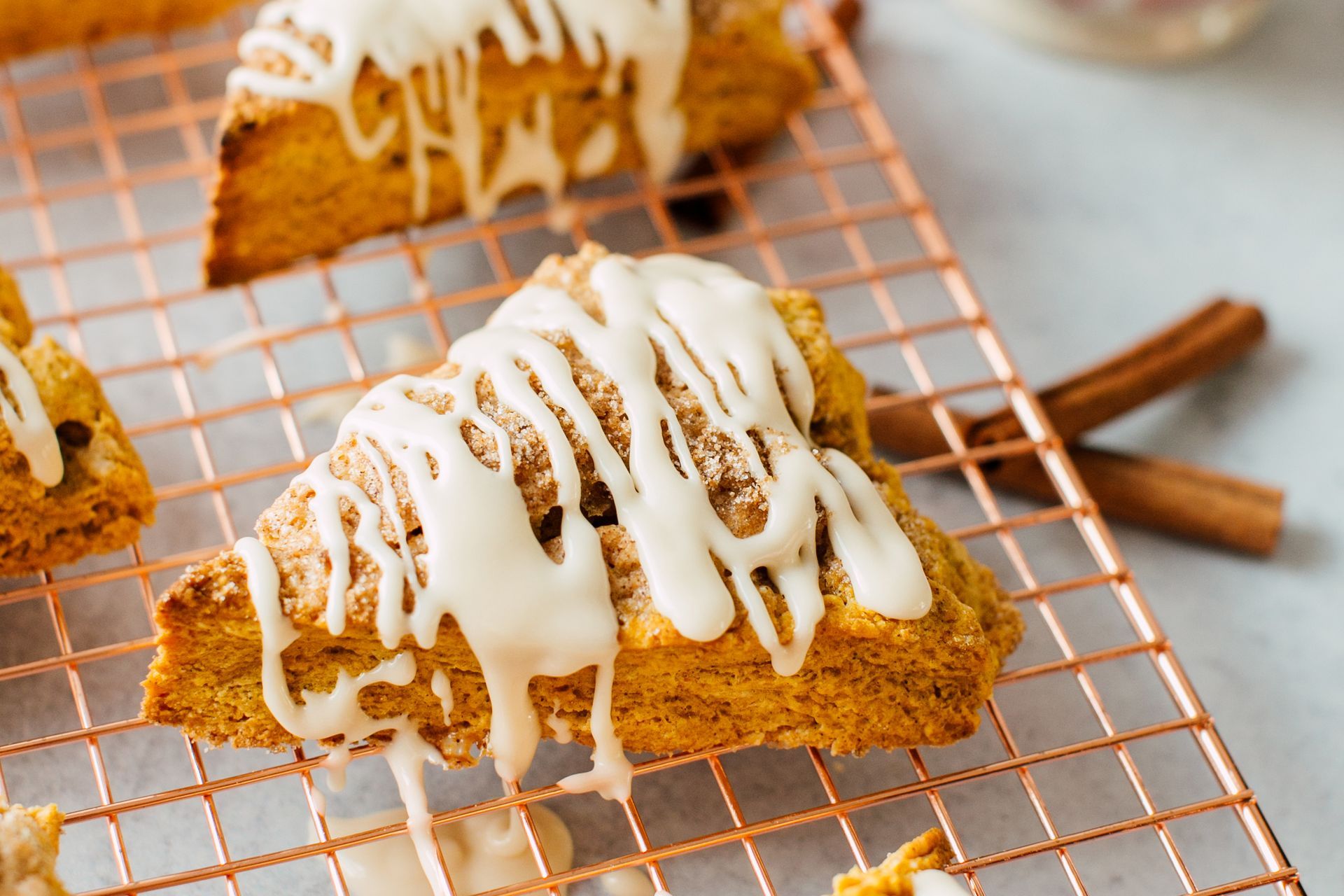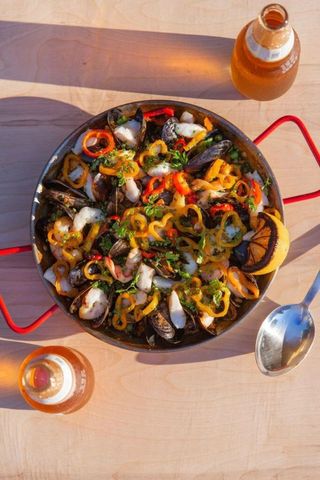Netflix & Grill With Chef Sebastian: Must-Try Summer Paella
CSSI Staff Post - September 2, 2020
Paella is a rice dish that hails from the Valencia region of Spain. It is one of the well-known dishes in Spanish cuisine. There is something magical to be said about this one-pot wonder, and I can remember the first time I took a bite of this vibrantly yellow masterpiece. Its presentation and unveiling at the table—with its inherently intoxicating aroma—created a powerful food memory I yearn to relive over and over again. I became obsessed. The depth, complexity and sheer comfort that derived from consuming this Valencian dish was heartwarming. It embodied all that was important for me and my connection with food. To me, there is nothing better than sharing great food in the company of friends and loved ones.
When asked to contribute a recipe that drew inspiration from something I’ve seen on Netflix, I immediately thought of paella and two separate episodes on The Final Table and Chef’s Table in which the chefs cooked their interpretations of paella. They told stories through the transformation of humble ingredients into something so magnificent, transcending generations of knowledge, history and love through the power of food. Food should not just be consumed for sustenance. It should be explored, celebrated and, most importantly, shared with friends and loved ones. Paella is my contribution to this segment, an expression of my love.
I encourage everyone reading this to give this recipe a shot. It might sound exotic and overwhelming to some, but I assure you that you will be happy with the results. Below, you will find my interpretation of this Spanish rice dish. Do not be deterred if you cannot source the exact ingredients or if you dislike seafood or some of the other components. It’s ok! Use ingredients you like to eat and find those friends or loved ones you want to share it with. That is most important. I hope you find the same comfort in this dish that I have a thousand times over!
Ingredients - Serves 2–4
4 Tbsp – Extra Virgin Olive Oil
2 each – Chicken Thigh, boneless, skinless, cut into bite-sized cubes
1/2 Cup – White Onion, small dice
2.5 Tbsp – Garlic, minced
2 Tbsp – Tomato Paste
4-5 cups – Chicken/Beef/Seafood/Vegetable Stock (Anything will do)
1.5 tsp – Smoked Paprika
1 tsp – Saffron Threads
1 cup – Bomba/Calasparra Rice (Any short grain rice will do)
To Taste – Salt
15-20 each – Mussels, de-bearded
1/2 Cup – Green Peas, frozen
1 each – Barramundi Filet, cut into bite-sized chunks (Any white fish fillet will do)
14 each – Shrimp, halved lengthwise
4 each – Sweet Peppers, sliced into rings
2 Tbsp – Chervil, picked (optional)
1 Tbsp – Chive, sliced (optional)
1 each – Lemon, halved, charred (optional)
Directions
- Gather all ingredients and do any necessary knife work or prep as listed above.
- If you choose to add char the lemon wheels, heat a sauté pan up with a touch of oil in the pan. Add the sliced lemons flesh side down and cook for 5-7 minutes on high heat until the lemons are charred. If you do not want to do this, you can simply cut the lemon into wedges.
- Heat up your pan and add extra virgin olive oil. Once hot, sauté the chicken for 2-4 minutes, par-cooking it most of the way. Remove the chicken and reserve for later use. The goal here is to build a solid ‘foundation’, trying to impart as much flavor to this one pan rice dish.
- Add the onions to the sauté pan and stir continuously for 3 minutes until they start to caramelize slightly. Add the garlic and cook for another 2-3 minutes until fragrant. If the pan seems a little dry, add more olive oil to your discretion. The onions and garlic should be lightly frying in the oil.
- Once the garlic and onions start to brown a bit, add the tomato paste, stirring the paste into the onions and garlic. Cook for about 1 minute.
- Add roughly 2 cups of whatever stock you decide to cook with to the pan, followed by the smoked paprika and the saffron threads. Using a non-reactive spoon, stir the mixture to deglaze the bits of onion, garlic and tomato paste that might have begun to stick to the bottom of the pan. We chefs call those little bits that stick to the pan “fond,” translating to the French term “le fond,” meaning “the bottom.” I like to look at fond as flavor, which really builds foundation to sauces, soups, stews and other dishes like paella!
- Add your rice and stir until the rice evenly coats the bottom of your pan. The stock should completely cover the rice. This is where I add my salt. If you add the salt now as the stock comes to a boil, it will evenly disburse, yielding a flavorful broth. Turn your heat up to a medium high heat. From this point on, you will want your paella to be simmering constantly for the remainder of the cooking process. This typically takes 15-20 minutes in total. I like only to stir the mixture for the first couple minutes and then leave it be for the rest of the process. You will notice over the next 6-8 minutes that the stock will start to evaporate. As this happens, add about 1 cup of stock at a time until the rice is submerged again yet remains at an aggressive simmer. Note that the larger the circumference of the pan, the quicker the liquid will evaporate. Do not worry about not knowing exactly how much stock to add. It will all come together at the end, I promise!
- About 10 minutes in, add the chicken back into the pan, evenly spaced out, followed by the mussels. Remember, try not to stir the pan!
- At this point you will notice that the granules of rice are starting to swell slightly from their original state. I encourage you every couple of minutes to carefully taste a grain of rice for tenderness. This will help you determine how much more stock to add to the dish. The goal is to add just enough stock at this point to maintain the slightest simmer.
- Add your peas across the paella pan followed by the shrimp and white fish. I like to wait until the rice has swollen about 5-6 times its original size and is 90 percent cooked before I add these ingredients.
- Turn your heat up as high as it will go. There should be very little to no stock left in the pan. Cook for an additional 2-3 minutes. Add the sliced sweet pepper over the top, remove from the heat and cover with foil.
- It is important to let this rest. I like to give it 8-10 minutes before diving in!
- Unveil in front of guests, adding any herbs of choice. I love the combination of chervil and chive, but I can assure you that any herb would taste just fine! Serve with charred lemon and/or lemon slices.
- ENJOY with your beverage of choice!






